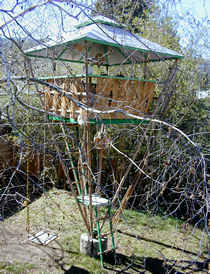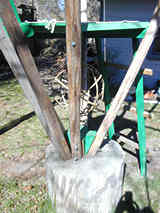A Path to Ecotectural Awareness
I became intrigued with the structural qualities and potential of bamboo. The impressive size and quality of a particular species of bamboo, native to Columbia, and now growing on my land, made it a resource that cried out to be used. That bamboo, Guadua angustifolia, is one of the ten super bamboos of the world. It can grow to a height of 120', with 10" to 12" diameter culms, or shoots, at its base. It is rot and termite resistant, split resistant, and has a long history of use in South America. I yearned to build a bamboo structure.
The design for the original "hooch," as I would come to call it, was dictated by site and material. A pre-existing foundation, our concrete septic tank, presented an easy perch to build upon. Although it measured only 5 by 7 feet, I could slant 24 foot bamboo poles radially up and outward, and achieve a floor area of 10 by 14 feet. This would allow a huge overhang, which would protect the bamboo from direct rain and sun, and thus extend the longevity of the structure.
We had chosen the West coast of Puerto Rico, among other reasons, for its proximity to the United States Department of Agriculture (USDA) Tropical Agriculture Research Station (TARS). Established in 1901, TARS is the only station of the USDA devoted to tropical agriculture, and boasts over 160 acres of exotic plant species from around the world, including many species of bamboo. I had developed a strong alliance with the station, visiting often to collect bamboo for my growing plantation. Fortunately for my project, a hurricane toppled a mature stand of Guadua that existed on the grounds of TARS and I was able to salvage enough poles for the project. With a summer's spare time effort, the hooch was built. Because the hooch was potentially unstable with it's large structure sitting on a relatively small foundation, I added cross cabling to surrounding trees and connected it to the main house with a well secured bridge.
The hooch became our master bedroom, equipped with a double bed. Lights and a fan were powered by my photovoltaic panels, salvaged from our boat. Its' self-sufficiency and structural integrity were soon demonstrated during and after hurricane Georges, a category three hurricane that made a direct hit on the West coast. As the storm raged through the night, I was able to watch the hooch strain and contort, always to spring back after the passage of each 120 mile-per-hour gust. If the hooch was to fly away, I wanted to see it go. It stayed.
The following morning, amid widespread destruction and leafless flora, the hooch stood, to the amazement of a crowd of post-hurricane gawkers—and me. I can only attribute the tenacity of the hooch to the incredibly flexible nature of bamboo, as well as its strength in both tension and compression. Though water and electricity was disrupted for over a month afterward, the hooch provided lighting and a fan as reliably as if nothing had happened—powered by my photovoltaic panels. The hooch was a truly a resilient asset, a structure resonant with all the qualities of an eco-tectural design: self sufficient, site specific, climate specific, and using local materials. It came to be the focal point of our home, a perch to view our growing garden, and a natural spot to put everything in perspective.
|
The Oregon Hooch has local Douglas
Fir poles in place of the bamboo used in Puerto Rico |
Although I had found my personal Shangri-La, it would not last. Reluctantly, a move to Oregon was orchestrated to provide my growing kids with a decent education. Though our new life was resplendent with new horizons, literally, the hooch was a place and an experience we all missed, and I endeavored to build another. Again, the design was predicated upon ecologic criteria, but now I took the design one step further. Instead of a permanent foundation, the hooch poles would converge to a single point upon which they would balance. A web of cables to surrounding trees would keep the hooch from falling over. Instead of bamboo, we would use a locally abundant and renewable resource, poles of Douglas fir. We built our first hooch, a 6' by 6' version, in the back yard of our rented house. It was an instant hit. Sleep-outs and parties were regularly scheduled. It became our personal "escape hooch," just to experience time amongst the tree tops, and time "outside the box."
The design leap to a point foundation and tensioned cables is, to me, beautiful. The design calls for prefabricated parts, with the efficient use of materials a primary requisite. The highly wind-resistant hip roof is equipped with a flip-open skylight. The open-wall design further aids resistance to winds, as I learned from our experience with the original hooch. The point foundation is truly cool. The wood slab upon which the poles rest serves as a fulcrum for any movement of the hooch resulting from stress, whether wind or earthquake induced. A triangulated diamond shape, the whole hooch structure moves as a unit significantly reducing stress on the joinery. The cables to surrounding trees literally tie the structure to its environment and make it a part of, rather than a part from.
|
Oregon hooch point foundation |
When at rest, which is most of the time, the hooch is balanced. The individual tensions of the cable network are equalized, with very little tension. The hooch is tied to the huge grip that the root systems of the trees have on the ground-a natural and extremely effective anchor. As a pseudo treehouse, the hooch shines. It is a pre-fabricated design that does not need to be altered specificially for each particular tree. It does not rely upon the conjectural and unreliable structural strength of the limbs of a tree. Yet it sits among the trees, a part of the trees. Finally, it is highly environmentally benign. It requires no site alteration, and indeed, has the smallest footprint of any land-based structure. Since it is pre-fabricated with through-bolts and screws, the hooch can be dismantled and moved easily, with no residual effect upon the site.
Though I had a vague notion of ecologic design, my continued research revealed that the hooch adhered to several important design principles. A probe of the local library yielded a book entitled Biomimicry, by Janine Benyus. As I read it, I felt as if someone had read my mind, and distilled my thoughts into a cohesive concept. Biomimicry, a design strategy mimicking those that have evolved in nature, was particularly applicable to the hooch. The similarities to a bamboo culm, or a grove of bamboo, were obvious. Each bamboo culm is tall, with a minimally-supporting shallow root system. Standing alone, a tall culm could easily be dislodged at its roots and topple. However, the intertwining branches of adjacent bamboo culms support one another, as do plants in a grove. Similarly, the tensioned cables support the hooch, which otherwise has no rigid base to keep it upright. Stress is distributed throughout the structure, minimizing point stress failure, and increasing overall resilience—just like bamboo. I like to further define this particular design strategy by assigning it the name: bamboomimicry. Stress distribution has been a very successful survival strategy for bamboo, and the grass family in general, and it certainly works for the hooch.
NEXT >>

